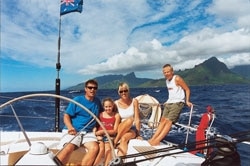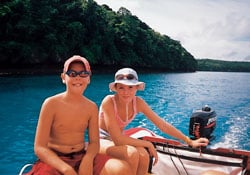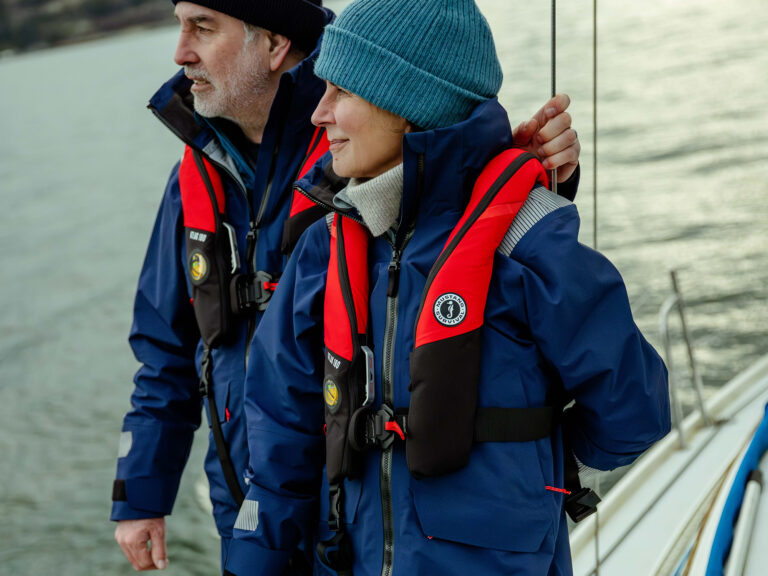
C07NE01.jpg
“Hey Dad, I’ve just plotted our position!” When I heard the voice from below, it was midafternoon, and I was on watch several days into an Atlantic crossing between the Canary Islands and Antigua. My family and I were aboard Carla M, a Beneteau First 47.7 we were delivering from Spain to Australia. The excited announcement was from my 9-year-old son, Vance. At the time, I hadn’t explained the nuances of latitude and longitude or the use of dividers and roller rulers. Apparently he didn’t need me to. I dropped below to see his handiwork, and sure enough, there marked in pencil on our chart of the North Atlantic was our position within a few miles–give or take a smudge or two. This bold step from observation to execution is a classic example of how kids absorb information from their environment, be it ashore or on a small boat in the middle of the ocean.
Months earlier, when Id been contracted to deliver the nearly new Beneteau from Europe to Australia, my wife, Cindy, and I decided to turn the trip into a family outing. Wed previously cruised full-time for nearly five years, two of them with our daughter, Annie, who was born in British Columbia while we were there between 1988 and 1989. In 1991, after returning to our homeland, Australia, via Mexico and the Pacific trade-wind route, our son was born and we moved ashore.
In the intervening years, we hadn’t done much sailing as a family due to work and to time-consuming projects, including my participation in the 1994-95 BOC Challenge. Annie was now 11, and Vance was 9; it was time to show them the sailing lifestyle. We estimated that the 13,000-nautical-mile trip would take us about five months. Our projected route took us from southern Spain across the Atlantic to Panama via the Canary Islands and Antigua, then to the Galápagos, French Polynesia, and Tonga before a winter approach to Australia and Carla M‘s new home port of Sydney. Having always admired the confidence and enthusiasm of children we’d met on boats, Cindy and I looked forward to seeing our kids develop over the coming months of this short but intense period of their lives. Following are the priorities we established before leaving and some of the things we learned along the way.
Safety First
Our primary goal was keeping the kids safe. While sailing is less hazardous than traveling in a car, we needed to reinforce certain rules. The random motion of a boat in a seaway can trip up even an experienced sailor, so we rigged jacklines fore and aft and made sure Annie and Vance wore harnesses anytime they went on deck. Though we were careful not to instill fear in the kids, we openly discussed what to do in certain situations–for instance, if someone went over the side. Since Annie and Vance were particularly interested in the radios, we allowed them to use and become familiar with the VHF and SSB.
Though investing in expensive foul-weather gear for the kids at first seemed excessive, since they’d likely outgrow it in a season, in the end we decided not to compromise–we bought them excellent foulies before leaving Spain. In their matching red, white, and blue jackets and pants, Annie and Vance sat watches with us day or night, even during squally weather. Being huddled together in the cockpit while dressed warmly and enjoying the night sky as we chatted and sailed along in Carla M fostered a feeling of closeness I’ll never forget.
Learning on the Go
Beyond keeping the kids safe, we wanted to be sure they kept up with schoolwork. After poking around a bit, we discovered that most people cruising used one of two curricula–distance-learning programs sanctioned by their government, or self-taught homeschooling. Though most families we met used the correspondence courses, we shied away from these because the curriculum seemed clumsy and made no allowance for the unconventional lifestyle of constant travel aboard a boat. It’s hard to sit your kid down for six hours of class when sailing in bumpy or unsettled weather or if the tide is right for diving on the reef. We adopted a less formal attitude, but we did bring material aboard for them in the areas of math, English, and science. Keeping up with their journals became a priority; each day, the kids would write a piece about what they’d done, then decorate the pages with designs and sketches to suit. Their school in Australia was enthusiastic about the trip, and before we left, their teachers put together a folder of work sheets for Annie and Vance. The kids would cram, often spending a whole morning or afternoon tackling several work sheets, which translated into a math or English binge. They thought it was all good fun and unwittingly covered lots of ground.
Still, we found that most of their education on the trip came from extracurricular activities. Meeting people from different walks of life helped build their self-confidence. I remember how good I felt one day when Annie and Vance looked into the eyes of adults previously unknown to them and, with hands outstretched, introduced themselves by name. Without a doubt, helping to run a boat and taking responsibility for specific tasks aboard helped develop maturity. And what better way is there to get someone interested in the geography and history of a country than to actually go visit it?
|
|
| |
|

|
| |
| Alan Nebauer|
| |
|
|
| |
| When Carla M stopped, it was time to explore. Here Vance and Annie use the inflatable to check out Vava’u island, Tonga.* * *|
| |
|
|
|
Meeting Other Kids
Kids need other kids as leveling influences in their lives. Our children enjoy hanging out with us, and they like each other (most of the time), but you could see their ears prick up when they heard a boat was around with kids aboard. After long passages at sea, when they did find playmates in port, they really let loose. As the kids knew they’d only be around for a short time, these relationships were intense and exhausting, and they’d play until they literally dropped. They couldn’t get enough. On meeting some young Aussie kids in Tahiti–a brother and sister about the same ages as Annie and Vance–it was like they’d known each other for years. There was no time for shyness or formal protocol; it was instant action and scary to watch. Over the next few days, there were many hours spent in the dinghy, building things with Legos, swapping and playing computer games, and exchanging favorite recipes. The kids ate their meals on whichever boat they happened to be on and stayed up way past their bedtimes. All too soon it was time to leave. Both sides howled in protest, but once out of the pass, Annie and Vance fell dead asleep or read quietly in their bunks. It took them several days to get over that session.
Looking Back
Early on, we discovered that passagemaking with children isn’t much different from parenting ashore–they’re both a challenge. But traveling aboard a small boat presents challenges we didn’t foresee. An obvious change was the lack of privacy. And some of the attributes we wanted Annie and Vance to gain–like confidence and inquisitiveness–often backfired on us, as at times it seemed as though no moment passed without some interjection or comment from the other side of the bulkhead or from out of the cockpit portlight. In retrospect, Cindy was less intimidated by taking the kids than I was. Most of my worries centered around how I’d balance the “dad” role with the responsibilities of a professional skipper, but this isn’t too different from life ashore. As parents, we’re all faced with the task of striking a balance between family time and ever-present work commitments.
Routine on board was dictated by the watches we took; when we left Spain, we were accompanied by Cindys sister, Vanessa, who came along as crew for the first leg of the journey. With three adults, it was easy to maintain a rigid schedule of three hours on, six off. Later, after Vanessa left us in the Galápagos, Cindy and I took four-hour watches. This worked well, though with just our immediate family aboard, the arrangements became looser and more relaxed. If one of us needed extra sleep, the other would allow it; we developed a casual, tit-for-tat system that permitted us the rest we needed while keeping a steady pace to suit our schedule. The kids helped out during the day and often volunteered for night watches, coming out fuzzy-eyed to keep Cindy and me company. They enjoyed this time because it gave them exclusive visiting rights with us, and we savored it as we came to know through conversation what our kids thought about many topics.
Both Annie and Vance enjoyed steering, but I was really impressed when, early on in the voyage, my son held the boat on course after a few simple instructions from Cindy. I watched and told him how notable I thought it was that hed picked it up so fast. He said that he “thought it was like a computer game–you just kept the line between the numbers.” Simple!
A highlight of the trip was waking up in Antigua after a nighttime arrival. Anchored in Falmouth Harbour, we woke to hear the kids on deck checking out our new surroundings. It sounded like Christmas morning as they oohed and ahhed with excited voices, seemingly identifying each feature of the anchorage. “Look, they even have palm trees. And check out that green house on the hill!”
“Where? I want to see. Give me the binoculars, Annie!”
They were delighted, and Cindy and I were enrapt listening to them point out ordinary things as if they were incredible new discoveries. Their interest and awareness had been enhanced by almost 20 days at sea–our first transocean passage completed together as a family.
Alan Nebauer is the author of Against All Odds: Around Alone in the BOC Challenge (McGraw-Hill, $20), the story of his 1994-95 campaign in which he won two medals for seamanship, one for rescuing British competitor Josh Hall.








